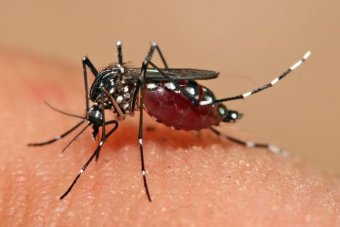
The Sunday Mail

Globally one child dies from malaria every minute and over 90 percent of these deaths are in Africa south of the Sahara. In Zimbabwe malaria is the third leading cause of illness coming after HIV and AIDS and Tuberculosis. Approximately 50 percent of the population is at risk of contracting malaria and all age groups are at risk.
Transmission is generally seasonal, starting from around November to the end of May, and the peak period is between March and May. Malaria accounts for between 30 to 50 percent of outpatient attendances in the moderate to high transmission districts during the peak transmission period.
Malaria is a disease of public health importance contributing significantly to illness and deaths in the country. More often than not, malaria is perceived not only as a disease of poverty but also as a cause of poverty.
Therefore, for purposes of effectively dealing with the broad ranging effects of the disease it is important to note that malaria is not just a health issue but a socio-economic one as well. Malaria has a direct impact on a country’s human resources.
Not only does it result in loss of life and loss of productivity due to illness and premature death, it also affects children’s school attendance and social development through both absenteeism and permanent neurological damages associated with severe episodes of the disease.
Malaria is a disease caused by the Plasmodium parasites. There are four types of the Plasmodiumparasitesthat infect humans and these are plasmodium falciparum, plasmodiummalariae, Plasmodiumovale, Plasmodium vivax.
The parasites are spread to humans mainly through a bite from an infected female Anopheles mosquito. The parasites can also be passed from pregnant woman to her unborn baby and through blood transfusion. Of the four plasmodium parasites types P. falciparum, is the most dangerous as it causes most of the infections and deaths in Africa.
In Zimbabwe P. falciparum is the most dominant parasite accounting for 98 percent of the cases. Plasmodiummalariae and p.ovale account for the other 2 percent of the infections. The disease is preventable,curable and it can be eliminated, but resurgence is always a possible threat.
◆ Prompt diagnosis with rapid diagnostic kits and microscopy and treatment of confirmed cases with effective medicines
◆ Early detection, containment and prevention of epidemics
◆ Strengthening of local capacities in basic operational research for development of interventions
◆ Advocacy, social mobilisation and programme communication to enhance involvement and participation of communities and other stakeholders in malaria control initiatives
◆ Surveillance, monitoring and evaluation and operational research
Zimbabwe uses a combination of strategies to prevent and control malaria, most of which have reached universal access. These include:
◆ indoor residual spraying (IRS)
◆ prompt diagnosis and provision of effective medicines to treat confirmed cases of malaria
◆ use of medicines to prevent malaria during pregnancy (intermittent preventive treatment in pregnancy (IPTp) ) in areas of moderate to high malaria transmission areas
◆ use of long lasting insecticide treated bed nets
◆ advocacy, social mobilisation and programme communication to enhance involvement and participation of communities and other stakeholders in malaria control initiatives
◆ early detection, containment and prevention of epidemics
◆ strengthening of local capacities in basic operational research for development of interventions
The malaria treatment policy for Zimbabwe stipulates that every suspected case of malaria should have rapid diagnostic test or microscopy done.
Treatment for malaria is given to only those who will have tested positive for malaria. It is very important to complete the course of treatment given to prevent development of resistant strains of plasmodium parasites.
Anyone who lives /visited an area with malaria transmission and suspects malaria should access testing and treatment with 24 hours of onset symptoms.
Zimbabwe joins the rest of the world in commemorating the World Malaria Day (WMD). The day is going to be commemorated in all the eight rural provinces, which are receptive to malaria transmission.
The WMD helps us increase awareness and knowledge towards the reduction of malaria deaths among children under five and pregnant women, and reminds us that malaria is a global problem requiring a globe wide solution. The 2016 World Malaria Day theme is ‘End malaria for good’ and the slogan for Zimbabwe is ‘Yes we can do it!’
The theme is building on the success of the MDGs to end malaria under the Sustainable development goals (SDGs)
Zimbabwe has made extraordinary progress in the fight against malaria. Malaria incidence declined by 79 percent from 136/ 1000 population in 2000 to 29/1000 population in 2015 surpassing the MDG targets of 75 percent.
Mortality declined by 57 percent from 1069 deaths in 2003 to 462 deaths in 2015.
The burden of malaria has significantly reduced from the central parts of the country, with most of the burden remaining in the border districts.
The country started implementing pre-elimination activities in all the seven districts of Matabeleland South province in 2012 and by 2015 these had increased to 20. Pre-elimination activities are implemented in districts that will have attained malaria incidence of less than 5/1000 population. In pre-elimination districts malaria becomes a notifiable disease and every case is investigated and household members and neighbours are screened for malaria.
Mosquito knows no boundaries and Zimbabwe continues to collaborate with the neighbouring countries on malaria prevention and control with an aim of harmonising strategies and malaria messages and synchronising implementation.
Inadequate resources were affecting the implementation of cross border activities.
However through regional collaboration and commitment SADC managed to get support from the Global Fund through the successful Elimination 8 (E8) Global Fund Grant. This has guaranteed the funds for addressing cross border collaboration activities. Some of the challenges include the re-emergence of malaria vectors – Anopheles funestus is resistant to Pyrethroids cheaper IRS chemicals.
This has seen the country introducing Organophosphates which are more effective but very expensive.



